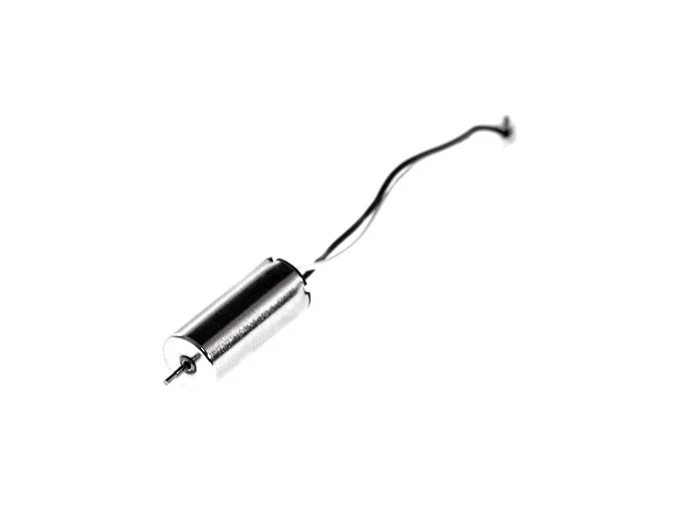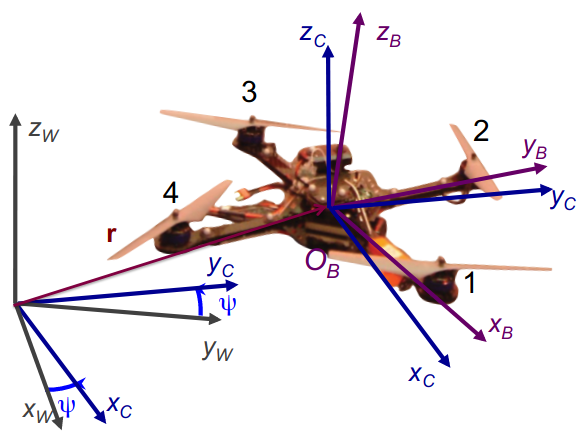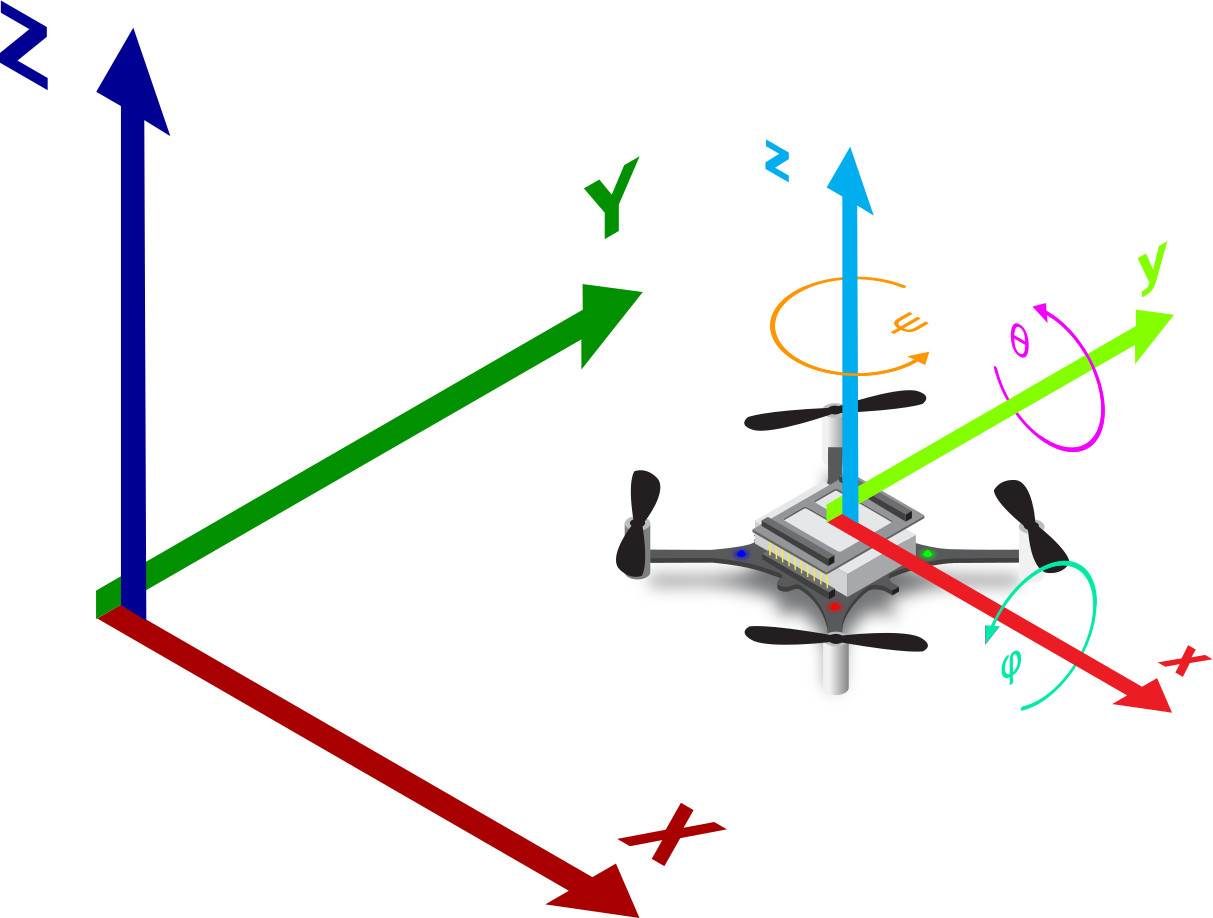Flying Robots
Multirotor Flight Dynamics
Wolfgang Hönig
October 25, 2024
Introductions Reloaded
About You
- Field of Study
- Robotics experience
- Programming experience
- Hopes/wishes for the course
Assignment 0
Assignment 0: Build a 2D Multirotor Simulator
- Good way to learn Rust and see if you like the course.
- Next week
- Discussion/presentation of your solutions
- Full 3D Multirotor dynamics and assignment 1
Did anyone attempt this?
Lets present/discuss results and challenges!
Basic Multirotor Flight Dynamics
Motors and Propellers
Brushed Motor
- Simple design
- Cheap
- Easy to control (e.g., pulse-width-modulation (PWM))

Brushless Motor
- More energy efficient
- More durable
- Controlled using an electronic speed controller (ESC)
- We typically control the angular velocity of a motor \(\omega_i\) (in rpm)
Motors and Propellers
- Once we add a propeller, each motor/propeller creates a force (upward) and torque (in the direction of rotation)
\[ \begin{align} F_i &= \kappa_F \omega_i^2\\ \tau_i &= \kappa_\tau \omega_i^2 \end{align} \]
- Both relate quadratically to \(\omega_i\)
- \(\kappa_F\) and \(\kappa_\tau\) are found through system identification
Frame
- Motors are rigidly attached to a frame
- Common: X-configuration or +-configuration (here: X)

- Why do the motors spin in different directions?
- Why do helicopters use two propellers?
Force Allocation
- Mapping the control outputs (\(\omega_i\)) to the force \(f\) and body torque \(\boldsymbol{\tau}=(\tau_x, \tau_y, \tau_z)^\top\) (acting on the center of mass)
\[ \begin{align} \boldsymbol{\eta} = \begin{bmatrix}f\\\tau_x\\\tau_y\\\tau_z\end{bmatrix} = \mathbf B_0 \begin{bmatrix}\omega_1^2\\\vdots\\\omega_K^2\end{bmatrix} \end{align} \]
- \(\mathbf B_0 \in \mathbb R^{4\times K}\) is the allocation matrix
Allocation Matrix Example Plus-Configuration

\[ \begin{align} \boldsymbol{\eta} = \begin{bmatrix}f\\\tau_x\\\tau_y\\\tau_z\end{bmatrix} = \begin{bmatrix} \kappa_F & \kappa_F & \kappa_F & \kappa_F\\ 0 & \kappa_F l & 0 & -\kappa_F l\\ -\kappa_F l & 0 & \kappa_F l & 0\\ \kappa_\tau & -\kappa_\tau & \kappa_\tau & -\kappa_\tau \end{bmatrix} \begin{bmatrix} \omega_1^2\\ \omega_2^2\\ \omega_3^2\\ \omega_4^2 \end{bmatrix} \end{align} \]
- \(l\): distance from the axis of rotation of the rotors to the center of the quadrotor
(From the seminal paper (Mellinger and Kumar 2011))
Reference Frame Crazyflie

Allocation Matrix Crazyflie

\[ \begin{align} \boldsymbol{\eta} = \begin{bmatrix}f\\\tau_x\\\tau_y\\\tau_z\end{bmatrix} = \begin{bmatrix} \kappa_F & \kappa_F & \kappa_F & \kappa_F\\ -\kappa_F a & -\kappa_F a & \kappa_F a & \kappa_F a\\ -\kappa_F a & \kappa_F a & \kappa_F a & -\kappa_F a\\ -\kappa_\tau & \kappa_\tau & -\kappa_\tau & \kappa_\tau \end{bmatrix} \begin{bmatrix} \omega_1^2\\ \omega_2^2\\ \omega_3^2\\ \omega_4^2 \end{bmatrix} \end{align} \]
- \(a=\frac{l}{\sqrt{2}}\)
Flight Dynamics
- State: \(\mathbf{x} = (\mathbf p, \mathbf
v, \mathbf R, \mathbf \omega)^\top \in \mathbb R^3 \times \mathbb R^3
\times SO(3) \times \mathbb R^3\)
- Position \(\mathbf p = (x,y,z)^\top\) [m, global frame]
- Velocity \(\mathbf v = (\dot x, \dot y, \dot z)^\top\) [m/s, global frame]
- Orientation \(\mathbf R\) [attitude rotation matrix]
- Angular velocity \(\boldsymbol{\omega} = (\omega_x, \omega_y, \omega_z)^\top\) [rad/s, body frame]
- Action: \(\mathbf{u} = (f_1, f_2, f_3, f_4) \in \mathbb R^4\) [N]
- Parameters
- Mass \(m\) [kg], Arm length \(l\) [m], inertia matrix \(\mathbf J\) [\(kg\cdot m^2\)], Gravity \(g\) [\(m/s^2\)]

Flight Dynamics
- Dynamics: \[ \begin{align} &\dot{\mathbf{p}} = \mathbf{v}, && m\mathbf{\dot{v}} = m\mathbf{g} + \mathbf{R}\mathbf{f}_u,\\ &\dot{\mathbf{R}} = \mathbf{R}\boldsymbol{\hat{\omega}}, && \mathbf{J}\dot{\boldsymbol{\omega}} = \mathbf{J}\boldsymbol{\omega}\times \boldsymbol{\omega} + \boldsymbol{\tau}_u, \end{align} \] where
- \(\hat{\boldsymbol{\cdot}}\) denotes a skew-symmetric mapping \(\mathbb R^3 \rightarrow SO(3)\)
- \(\mathbf{g} = (0,0,-g)^\top\) is the gravity vector
- \(\boldsymbol{f}_u = (0,0,f)^\top\)

Flight Dynamics Challenges
- What’s the “skew-symmetric mapping”?
\[ \boldsymbol{\hat{\omega}} = \begin{bmatrix} 0 & -\omega_z & \omega_y\\ \omega_z & 0 & -\omega_x\\ -\omega_y & \omega_x & 0 \end{bmatrix} \]
- Not every \(3\times 3\) matrix is a
rotation matrix
- needs to be orthogonal
- needs to have determinant 1
These properties need to be enforced after integration!
Rotation Representations
- Rotation Matrix
- Highly over-parameterized (9 entries for 3 rotations)
- Euler Angles
- Singularities that can cause a gimbal lock
- Quaternions
- Difficult to understand
Quaternions
- A quaternion is represented as \(\mathbf q=(q_w, q_x, q_y, q_z)^\top=(q_w,
\vec{\mathbf q})^\top \in \mathbb R^4\)
- we denote \(\vec{\mathbf q}=(q_x, q_y, q_z)\)
- we augment a point \(\bar{\mathbf r}\in\mathbb R^3\): \(\bar{\mathbf r} = (0, \mathbf r)^\top\)
- For rotations we have \[\mathbf
q=\begin{pmatrix} \cos(\theta/2)\\ \mathbf u \sin (\theta/2)
\end{pmatrix}\]
- \(\theta\) is the rotation angle
- \(\mathbf u\in\mathbb R^3\) is an axis
- \(\| q \|_2 = 1\) (unit quaternion or normalized quaternion)
Quaternion Operations
Negation: \[ -\mathbf q = (-q_w, -q_x, -q_y, -q_z)^\top \]
Addition: \[ \mathbf q \oplus \mathbf p = (q_w + p_w, q_x + p_x, q_y + p_y, q_z + p_z)^\top \]
Multiplication: \[ \mathbf q \otimes \mathbf p = \begin{pmatrix} q_w p_w - q_x p_x - q_y p_y - q_z p_z\\ q_x p_w + q_w p_x - q_z p_y + q_y p_z\\ q_y p_w + q_z p_x + q_w p_y - q_x p_z\\ q_z p_w - q_y p_x + q_x p_y + q_w p_z \end{pmatrix} \]
Quaternion Operations
Conjugate \[ \mathbf q^* = (q_w, -q_x, -q_y, -q_z)^\top \]
Norm: regular \(L_2\) norm on the vector \[ \| \mathbf q \| = \sqrt{q_w^2 + q_x^2 + q_y^2 + q_z^2} \]
Quaternion Vector Rotation
With a rotation matrix \(\mathbf R\), we can rotate a vector \(\mathbf v\) as \[\mathbf v_{rotated} = \mathbf R \mathbf v\]
With quaternion \(\mathbf q\) \[ \overline{\mathbf v_{rotated}} = \mathbf q \odot \mathbf v = \mathbf q \otimes \overline{\mathbf v} \otimes \mathbf q^* \]
(I.e., augment \(\mathbf v\) to a quaternion, use two quaternion multiplications, and one conjugate, and then extract the vector part of the result)
Quaternion Derivative
Assuming \(\boldsymbol{\omega}\) in body frame (e.g., gyroscope): \[ \dot{\mathbf q} = \frac{1}{2} \mathbf q \otimes \overline{\boldsymbol{\omega}} \]
Assuming \(\boldsymbol{\omega}\) in world frame \[ \dot{\mathbf q} = \frac{1}{2} \overline{\boldsymbol{\omega}} \otimes \mathbf q \]
For integration, we can use Euler or RK4, but need to enforce \(\| \mathbf q \|_2 = 1\) afterwards.
Improved Quaternion Integration
- A rotation starting from \(\mathbf q_t\) with fixed angular velocity \(\boldsymbol{\omega}\) (body frame) for a (small) \(\Delta t\)
\[ \mathbf q_{t+\Delta t} = \mathbf q_t \otimes \begin{pmatrix} \cos{(\| \boldsymbol{\omega} \| \Delta t/2)}\\ \frac{\boldsymbol{\omega}}{\| \boldsymbol{\omega} \|} \sin{(\|\boldsymbol{\omega}\| \Delta t/2)} \end{pmatrix} \]
Quaternion References
More details and derivations at (Särkkä 2007; Jia 2024; Narayan 2017)
Flight Dynamics Reloaded
\[ \begin{align} &\dot{\mathbf{p}} = \mathbf{v}, && m\mathbf{\dot{v}} = m\mathbf{g} + \mathbf{q} \odot (0, 0, f)^\top,\\ &\dot{\mathbf q} = \frac{1}{2} \mathbf q \otimes \overline{\boldsymbol{\omega}}, && \mathbf{J}\dot{\boldsymbol{\omega}} = \mathbf{J}\boldsymbol{\omega}\times \boldsymbol{\omega} + \boldsymbol{\tau}_u, \end{align} \] where \[ \begin{align} \begin{bmatrix}f\\\boldsymbol{\tau}_u\end{bmatrix} = \mathbf B_0 \begin{bmatrix}\omega_1^2\\\vdots\\\omega_K^2\end{bmatrix} \end{align} \]
Advanced Topics
System Identification
- mass \(m\), arm length \(l\): scale, ruler
- inertia \(\mathbf J\): often estimated from CAD models
- motor and propellers: trust stand
- for forces, this can be a scale where the UAV is mounted upside down
- Example from 2015
- Modern Commercial Thrust Stand
All important values were identified in a BS thesis (Förster 2015).
Modeling Wind
- In the dynamics, add an external force \(\mathbf{f}_a\)
- might depend on time or location
\[ m\mathbf{\dot{v}} = m\mathbf{g} + \mathbf{q} \odot (0, 0, f)^\top + \mathbf{f}_a(\mathbf p, t) \]
Modeling Drag
- In the dynamics, also add additional force \(\mathbf{f}_a \propto \mathbf v\) and torque \(\boldsymbol{\tau}_a \propto \boldsymbol{\omega}\)
Rotor Placement
How many controllable degrees-of-freedom does a Quadrotor (like the Crazyflie) have?
- If we place motors not in a single plane, we can control orientation
while staying in place
- Fully actuated UAV (Rashad et al. 2020)
- downside: less energy-efficient

Dynamics Learning
- Difficult to model everthing
- ground effect: a force when hovering close to the ground
- interaction forces: forces when two UAVs are in close (vertical) proximity
- Typical approach:
- Collect data
- Use supervised learning to train (residual) models
Examples: (Bauersfeld et al. 2021; Shi et al. 2022; Smith et al. 2023)
Existing Simulators
- Many: recent survey lists 44 (Dimmig et al.
2024)
- Some are generic robotics simulators (Gazebo, MuJoCo, Webots, Isaac Sim)
- Some are highly specialized (e.g., for training RL agents)
To understand how a robot works \(\Rightarrow\) build your own, like in this class.
For practical use-cases: use one of the existing ones (guidelines: see survey paper).
Assignment 1
Task
The goal of this assignment is to build a dynamics simulator for the Bitcraze Crazyflie 2.1 robot. This simulator will be extended in the upcoming assignments to test controls, state estimation, and motion planning.
Experiment on Simulation Quality
Compare (runtime/step size/solution quality) of two different integration schemes you have learned. Options:
- Pure Euler integration,
- Pure RK4 integration,
- Exponential map for quaternion integration, Euler otherwise
- Exponential map for quaternion integration, RK4 otherwise
Dynamics Validation
Given: state and action sequence of a sample flight.
Goal: Verify that the dynamics are correct.
Integrating over the whole trajectory does not work, as small numerical differences can lead to largely different results.
Integrate over \(k=1...10\) time-steps, and compare the simulated states and real states instead.
Rust Hint: Operator Overloading
use std::ops::Add;
#[derive(Debug, Copy, Clone)]
struct Vec3 {
x: f32,
y: f32,
z: f32,
}
impl Add for Vec3 {
type Output = Self;
fn add(self, other: Self) -> Self {
Self {
x: self.x + other.x,
y: self.y + other.y,
z: self.z + other.z,
}
}
}
fn main() {
let a = Vec3 {x: 0.0, y: 1.0, z: 2.0};
let b = Vec3 {x: 3.0, y: 4.0, z: 5.0};
let c = a + b;
println!("{:?}", c);
}Conclusion
Learned Today
- Multirotor dynamics
- Efficient and numerically stable handling of rotations via quaternions
- Outline of Assignment 1
Next Week
Discussion session: bring your code and any questions!
Official Registration
On MOSES until Nov 1st (midnight).
References / Suggested Reading
Questions
?